Last week, we chatted briefly about variegated threads. I’ve talked about using variegated threads for hand embroidery before, and at the end of this article, I’ll link to a few previous discussions and projects where variegated embroidery threads have played a role.
In a two-part series of articles, I’m going to share with you four different ways you can use variegated threads in hand embroidery, each way giving a slightly different result to your finished stitching.
In Part I of this series, we’ll look at the first two simple ways you can use variegated threads. They require no planning or forethought and no special approach. In Part II of the series, we’ll look at two different ways to use variegated threads, equally easy, but which require a little more planning or forethought.
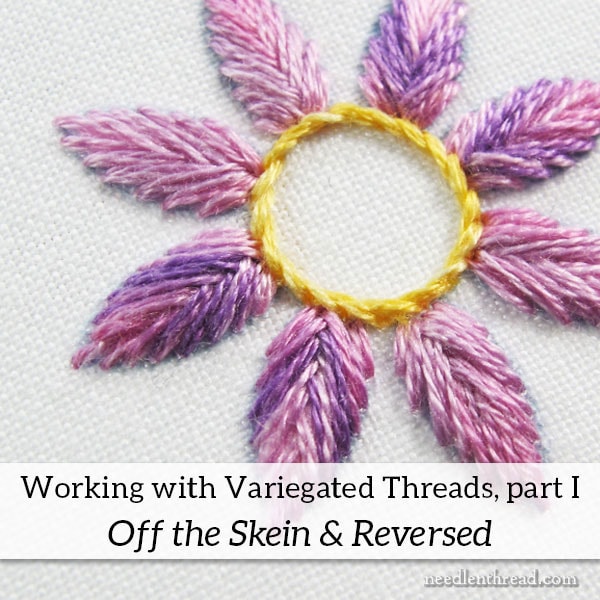
One of the advantages of using a variegated thread – that is, a thread that features different colors or shades in patches or streaks – is that you have, within the one thread, some variety. You can purchase and stitch with just the one thread, without changing colors or shades as you go, and still achieve a multi-colored (or shaded) element.
So in a sense, variegated threads can make embroidery with multiple colors or shades easier and more economical.
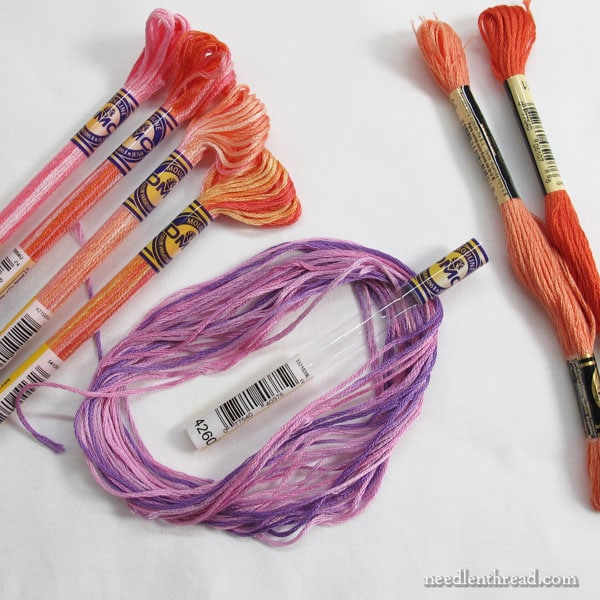
The supplies I’m using in this series of articles are pretty simple! I’ll be stitching on white cotton fabric, using DMC Variations embroidery floss, as well as one DMC solid.
I’ll be stitching each element with three strands of floss, using a #7 crewel needle. My fabric’s set up in a wooden hoop, and I’ve got a pair of sharp, small embroidery scissors on hand.
The elements are all identical – simple flowers made of eight petals and worked in fishbone stitch, starting at the top (12 o’clock) petal, and working clockwise around the flower. Each petal begins at the outer tip and is stitched from tip to base.
If you are unsure of how to work the fishbone stitch, you can find a tutorial for fishbone stitch here.
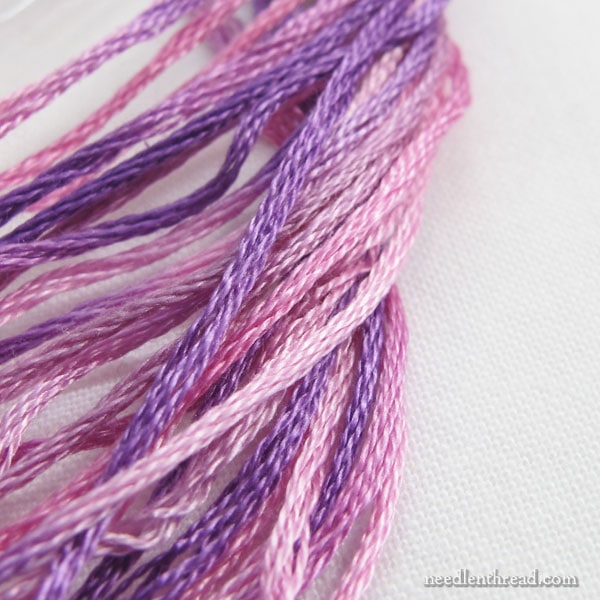
For the samples in the series, I’m going to use the same color number of Variations – specifically, 4260, which is a pink to purple variegated thread. It includes elements light pink, dark pink, soft pink-purple, and a darker purple.
All those colors move into each other gradually, so that the shade deepens along the thread until it begins to switch to the new color.
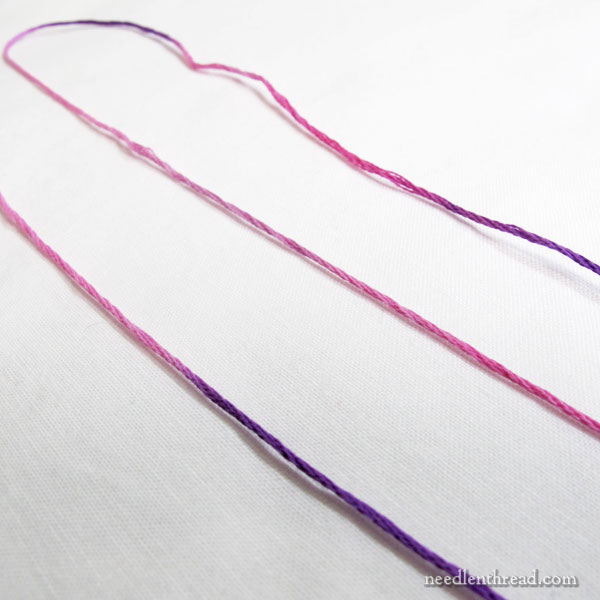
I find it useful, before stitching with a variegated thread, to un-skein it and get a good look at the sequence of the color changes. That way, I know what I’m going to be working with and I know what’s coming up as I stitch.
I can also get a good idea of which shades I want to emphasize and which shades I might want to play down a bit.
For the first sample, I’m using the thread straight off the skein, with no plan and no consideration of the way the colors fall.
I simply cut a length of the thread straight off the skein and separated out three strands to stitch with.
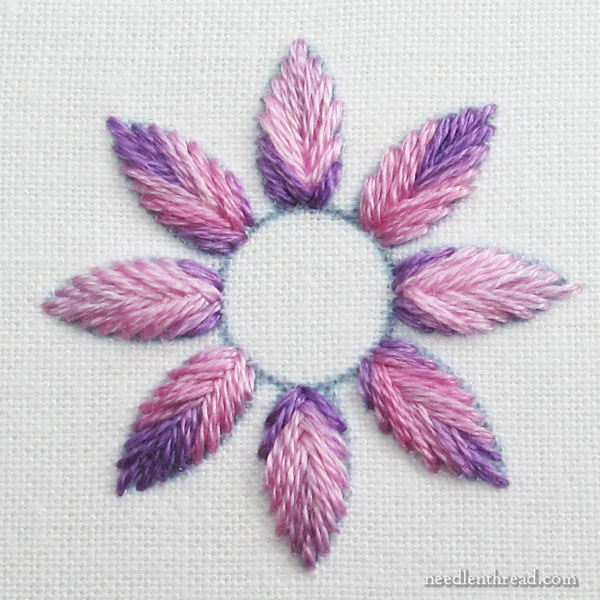
With the first sample, using the variegated thread straight off the skein, I was able to stitch three petals before changing the thread. I started at the tip of the 12 o’clock petal and moved to each new petal, starting at the tip again.
You can see how the second petal to the right of the top center carries the purple from the base of the first petal to the tip of the second.
This is ok, if you want that random placement. All the way around the flower, in fact, the darker purple is fairly patchy and it shows up mostly at the tip or the base of the petal. It is just happenstance that there is no dark purple patch in the middle of any petal.
Overall, it looks fine, but it’s evident that there’s no planning – all the colors fall rather randomly, and the switch between shades is somewhat harsh, even though the transitions on the thread come across as slightly more subtle.
Remember, your thread has to travel on the back of the fabric, too, when working a stitch, so sometimes the transitions on variegated threads are less subtle on a stitched element because the transitions might actually happen on the back of the fabric during the normal movement of making the stitch.
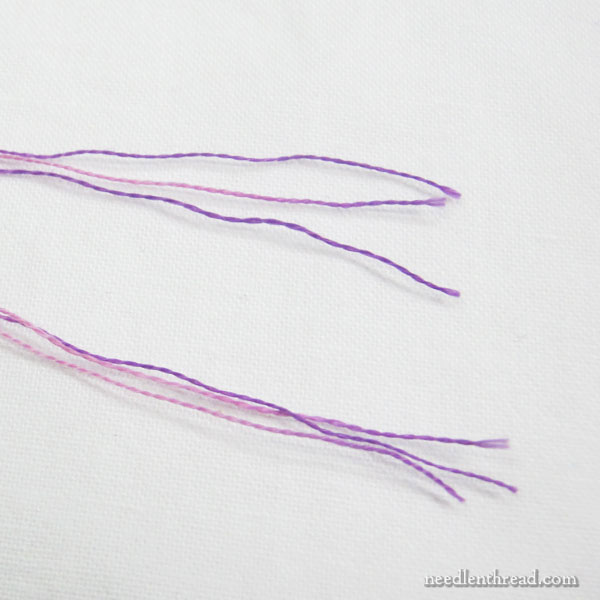
For the second sample, I cut my thread straight from the skein, and then separated out three strands.
I took one of the three strands and reversed its direction. You can see in the photo above that the two ends of the group of three threads have one thread that features a different color sequence. This is because I reversed the direction of the thread, so the color sequence in the reversed thread will not line up with the color sequence in the other two threads.
This should result in a slightly softer look to the whole flower, with (hopefully) a somewhat heathered effect. That is, the color should be a little sketchy, with flecks of color coming across here and there, rather than patchy chunks of color throughout.
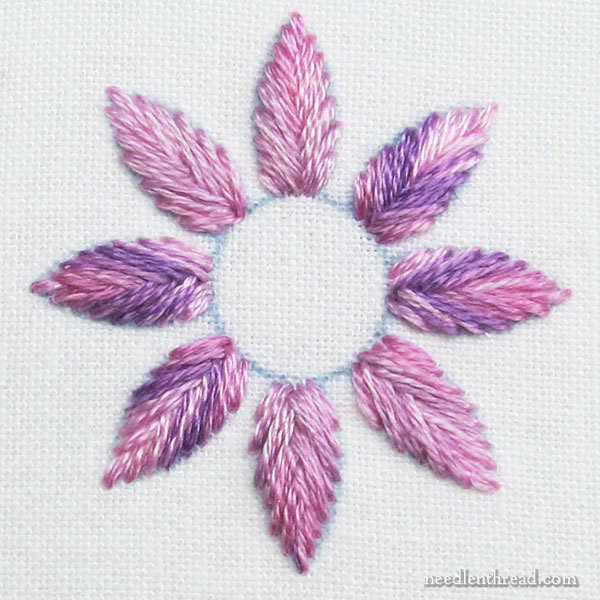
Here is the resulting flower. There are certainly fewer patches of solid purple, and the petals sporting the mostly-pink color ways are definitely not as noticeably variegated. They look slightly heathered, with flecks of color rather than larger patches of color.
When working with two strands of variegated floss, switching the direction of one strand will result in a much more heathered look to the stitching. With three strands, the softer heathered look is perhaps not as noticeable, but it does soften the variegated layout.
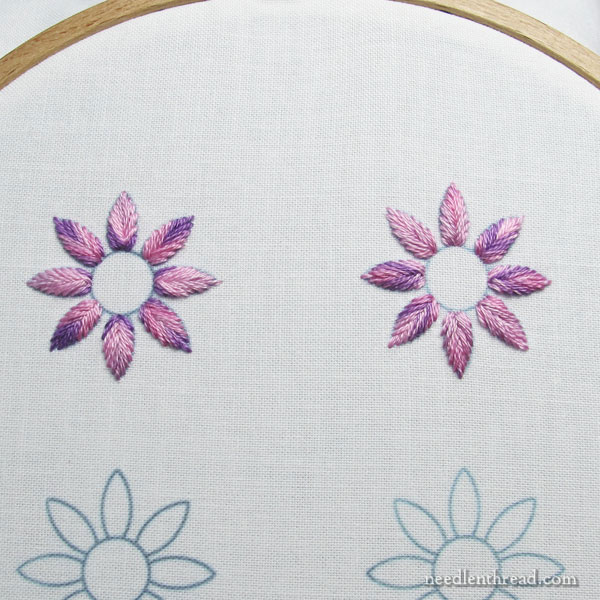
Above, you can see the two flowers together. The flower on the left was stitched with the variegated floss straight off the skein. The flower on the right had one strand of variegated floss reversed.
Notice that the colors are more patchy and distinct in the flower on the left, and on the right, they are slightly sketchier, with softer transitions.
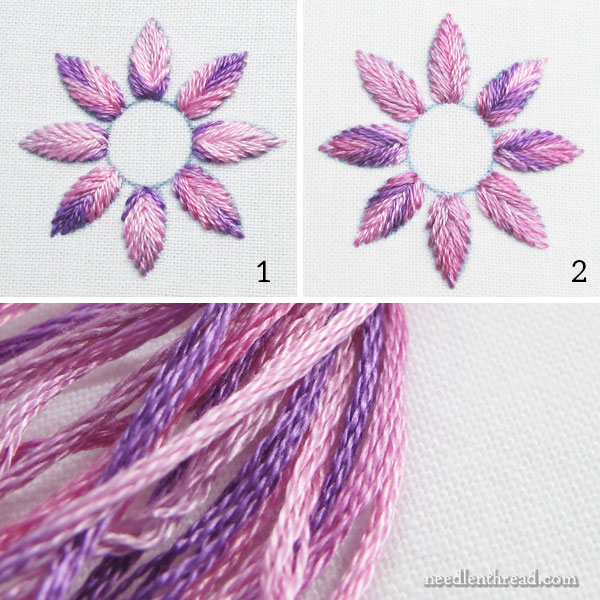
The colors in the skein of Variations are well represented in both flowers, but neither flower displays any controlled idea of color layout, or any real consistency of any one color throughout every portion of every petal. And that’s fine! That’s the nature of working with variegated floss with these two approaches.
In the next article, we’ll look at what happens when we add a little forethought to stitching and a little control to the threads.
Read More about Stitching with Variegated Threads
Needle Arts Class: Color Control – Here, you’ll see some demonstrations of color control with variegated threads during a high school needle arts class I taught a while back.
DMC Coloris & Corresponding Solids – This article includes a PDF printable for corresponding solid DMC colors for Coloris as well as for Variations. Scroll towards the end of the article for the links for the PDFs.
Overdyed Threads: Your Take? – In this article, I presented Colour Complements before it was Colour Complements! I also asked for your take on overdyed threads. Read the comments – there’s always good information from the wider Needle ‘n Thread community in the comments!
Variegated Embroidery Thread & Ribbed Wheels – This article focuses on using variegated thread to stitch tiny ribbed wheels on the side of a monogram. You’ll see how the subtle color change enhances the elements on the monogram, without having to switch out colors,
Two Stitches, Two Threads, and Done in One Day – The sample in this article features variegated floss with long and short stitch as a filling. It worked well, achieving a subtle pink-lemonade variety in colors without having to switch threads.
Simple Straight Stitched Flowers – Take a simple straight stitch flower like the ones featured in this article and stitch them with variegated threads, and you’ll have an instant floral success!
This Coloris Kaleidoscope project demonstrates how you can combine variegated and solids to create a controlled use of variegated color.







Thank you so much for this article. The pictures help immensely. I’m working on an embellished applique quilt and have been using some variegated threads, especially on leaves. This article has helped me to visualize a little better the results of how I place the threads.
Your site is a treasure trove of information. Thank you!!!
So much to read and learn from this article, Mary! Thank you for posting all this information! I’ll have to make many return trips here to soak it all in!!
Thank you so much for this series, Mary – I’m really looking forward to part two! I had figured out the reverse strand trick myself a few years ago through much trial and error but it is amazing to see the stitched samples and have a reference article like this. I love the Colour Variations lines, and overdyed threads in general, but I’m never sure how to use them most effectively. Your simple flower pattern shows it off beautifully too!
Love this article. I have not favored verigated thread because it never seemed to flow naturally from one piece to the next within the composition. So any ideas and tips are appreciated! Thanks Mary!
Dear Mary
A very interesting article on variegated threads. You can actually see the difference between the straight of the skein and one strand reversed thread. I know you have written about this before but I didn’t realise that you could change how a design looks using variegated threads I will have to try this next time I use the thread. Just out of interest what cotton fabric are you using. Thanks for sharing with us how to stitch with variegated threads and for the links to your other articles on the subject.
Regards Anita Simmance
What a brilliant idea to reverse one thread! Thank you!
I have always loved variegated thread, even the early ones that went from white up to the primary dark color and back again. Talk about stripes. I used to think of how to make the transition of colors easier, and this was as a kid back in Junior High School.
When you showed the photo of the flower with one strand reversed, I could see the change but wanted to be able to do a side-by-side comparison and then there it was! Thank you. So many folks when trying to teach how to make craft items use about 3-4 steps and 3-4 photos from a distance to try to illustrate what you should be doing, but easy to miss the details. I have loads of embroidery floss as well as a huge amount of Watercolour Pearl cotton in about 50 shades. So many designed don’t use them, mine are usually sitting and waiting for the right project to come along, although I have known about the trick of reversing a thread for a long time. Thanks for the lesson and I look forward to the next one. You are a National Treasure!
This article answered many questions that I have had about variegated threads. I like the richness of their look but didn’t know how to use them so they didn’t look… well… just … variegated. Looking forward to Part II. ❤
Thank you so much for this helpful article, and all your immensely helpful site. I have learned so much from you!
Please, can you tell us exactly which design-transfer method you used here? I’ve read through all your tips for beginners articles, and they are so helpful. But I think the design transfer here and in the last few posts is just so perfect and clean. It is dressmaker’s carbon (a method I have not yet tried)?
Would so appreciate knowing! Thank you.
How come I never thought of the obvious…reversing strands of variegated thread…she said as she slaps her head. Thank you for sharing how to work with variegated threads, Mary, and thanks for the visuals!
Thank you Mary, I had never thought of varying the pattern of the variegation.
While your suggestion will not help with this, my husband does weaving on a rigid heddle loom and sometimes is rather disappointed with the resulting color pattern when using variegated yarns – especially when both the warp and weft are the same yarn. The point where he needs to add in a new piece of yarn can throw the entire pattern even further off.
I have always avoided variegated floss. Now I am getting brave enough to try.
Mary… I have not used variegated thread for years as I remember that I had disastrous results and had to snip it all out of the picture! Thanks for helping me to see “out of the box”. I can’t wait to read part two of this article!
Regards,
Bonnie
Wow, I had no idea about the reversing 1 thread. It makes such a difference. I wonder if shifting the threads has the same effect? Say you have a variegated floss with 3 colors and shift each thread just a bit (not reversing one). Hmmm – something to experiment with. Especially since I acquired a huge amount of variegated floss at an estate sale last week.